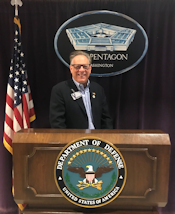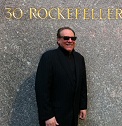NanoBusiness Alliance Congratulates 5 Nanotechnology PECASE Winners
Posted on February 17th, 2010 | No Comments »
Dean Kamen http://www.dekaresearch.com/index.shtml, Inventor, Scientist, PhD, was our Keynote Speaker at our September 2009 Conference. Mr. Kamen’s central premise was that America is a celebrity driven culture and children and adults cannot name one living scientist or engineer but can name 10 celebrities in seconds. Mr. Kaman’s 90-minute speech http://www.usfirst.org/ hit me hard and I www.vincentcaprio.org have taken up his challenge to highlight young leaders in the Nanotechnlogy community.
This week, we continue our look at some of the rising stars of nanoscience. Let’s jump ahead to the most recent group of Presidential Early Career Award for Scientists and Engineers (PECASE) recipients, who were honored at the White House on January 13th (photo attached). Among those selected for awards were nanotechnologists nominated by the Department of Energy, the National Institutes of Health, the Department of Defense, and the Department of Commerce.
Gary Baker, a chemist at the Department of Energy’s Oak Ridge National Lab, was nominated by DOE for pioneering work in synthesizing new environmentally sustainable solvents and exploring their applications. Baker and his colleagues are developing low-vapor-pressure solvents, known as ionic liquids, which could replace less “green” fluids in a wide range of chemical processes including the production of energy from biomass and fuel cell electrolysis. Nanotechnology enters Baker’s work in two different ways. First, he employs ionic liquids as part of a new technique for making uniform-sized nanoparticles called the melt-emulsion-quench approach. This can be used to synthesize a variety of magnetic and non-magnetic materials useful for drug delivery, magnetic resonance imaging, and protein separations. Second, as part of his program to better characterize ionic liquids, Baker has developed innovative nanostructured sensors with unique optical properties. Baker’s group uses these sensors for precision spectroscopic measurements using techniques such as surface-enhanced Raman spectroscopy. These sensors could find many other uses, for example in monitoring catalytic processes or performing bioassays in medical laboratories.
Jeffrey Neaton also represents the Department of Energy, through the Lawrence Berkeley National Laboratory. Neaton directs the Theory of Nanostructured Materials Facility at the LBNL’s Molecular Foundry. Neaton’s computational support group provides access to Nano, a 432-processor Linux cluster with a theoretical peak performance of 3.1 Teraflops. Nano is devoted exclusively to nanoscience projects undertaken by the Foundry’s staff and participants in the lab’s extensive program for outside users. Neaton himself has performed important calculations of electron flow in nanowires, molecular transistors, and other nanoscale electronic or optical devices. He works closely with experimental colleagues – both Foundry staff and users from industry or academia. Their goal is to simulate the fundamental physics of devices which combine inorganic and organic materials in nanostructures, and to see how mechanical strain and interfacial phenomenon effect device performance. By leading to a better understanding of the behavior of nanoelectronic and nanophotonic devices, this work could help us engineer practical, inexpensive solar cells, solid state lighting products, and low-power high-performance electronics.
Bruce J. Hinds, nominated for PECASE by the National Institutes of Health, is the William Bryan Associate Professor of Chemical and and Materials Engineering at the University of Kentucky. Hinds’ award recognizes his efforts to exploit the properties of carbon nanotubes to improve the delivery of drugs via skin patches. Hinds has developed techniques for aligning carbon nanotubes across a thin membrane, and for precisely placing chemical groups at the tube ends. Water can flow through the aligned nanotubes virtually friction free, a surprising effect that several groups are exploring for low-pressure filtration systems. Hinds, on the other hand, has developed a method to precisely functionalize the ends of the nanotubes, allowing him to control the passage of various molecules through his membranes. Recognizing that this kind of selective transport mimics the biological action of protein channels, Hinds went one step further and incorporated electrostatic control elements to simulate a gated ion channel. NIH’s National Institute on Drug Abuse is supporting Hinds’ work to develop these electrically controllable membranes into a better system for delivering drugs through the skin in a highly controllable fashion. Initial efforts focused on three drugs are already widely used with conventional transdermal patches: Clonidine (for opiate withdrawal therapy), fentanyl (for pain management), and, perhaps best-known, nicotine (for smoking cessation).
Seth R. Bank, an Assistant Professor in the Electrical and Computer Engineering Department at the University of Texas, was nominated by the Department of Defense along with Rashid Zia of Brown University (profiled in our January 15th newsletter). Professor Bank works with electronic devices built from III-V semiconductors, which he grows using the now-standard technique of molecular beam epitaxy. But by adding a decidedly non-standard component to the mix – semi-metal nanoparticles – he can modify key electronic parameters of the materials in desirable ways. Increased phonon scattering can be used to create better thermoelectric generators, for example, by decreasing thermal conductivity. In just over three years at UT, Bank has already established an advanced MBE facility, demonstrated tunnel junctions with 225 times the current of the best previous devices, and collaborated with a solar industry start-up on using nanocomposite semiconductors to improve the interlayer connections in multijunction photovoltaic cells. He is also building mid-infrared solid state lasers and Terahertz radiation sources, exploring parts of the electromagnetic spectrum of great interest for communications, remote sensing, and medical applications.
Dean DeLongchamp, a chemical engineer at the National Institute of Standards and Technology, was nominated by the Department of Commerce for his work to improve organic devices for flexible circuits, displays, solar cells, and energy storage. DeLongchamp is developing a suite of measurement techniques which allow scientists to measure the microscopic and nanoscopic structure of an experimental device design and correlate these features with processing parameters and ultimate performance. DeLongchamp’s personal specialty, Near Edge X-ray Absorption Fine Structure spectroscopy, or NEXAFS, utilizes the bright and highly focused X-ray beams from a synchrotron light source to determine the composition and orientation of molecules in an organic film. The measurement suite he is developing at NIST also includes scanned probe microscopy, electron microscopy, polarized light spectroscopy at X-ray, visible, and infrared wavelengths, and light scattering. Recently, DeLongchamp worked closely with Merck scientists to show how layer tilt and the interleaving of side chains contribute to high carrier mobilities in films of the organic semiconductor pBTTT. Other industrial collaborators including Corning, IBM, and Plextronics are using similar studies to guide the development of materials and processing techniques for organic electronic applications.
We hope to see you in Washington DC http://nanobusiness.org/index.php/public-policy March 15-17th for our Annual DC Event. Attached you will find a registration form. To register please email alisa@nanobusiness.org.
Regards,
Vincent Caprio “It’s Green, It’s Clean, It’s Never Seen – That’s Nanotechnology”
www.vincentcaprio.org
Executive Director
NanoBusiness Alliance
203-733-1949
vincentcaprio@nynanobusiness.org





